Discover the Benefits of Air-Purifying Plants in Offices for Wellness

Air-purifying plants enhance air quality, eliminate harmful toxins, and foster a healthier indoor environment.
Whether it’s a snake plant, rubber plant, or peace lily, these natural air purifiers transform your office into a productive, fresh-air haven.
Are you feeling tired or distracted at work? Poor indoor air quality could be the culprit. So, we need to know the Benefits of air-purifying plants in offices.
Offices are often filled with indoor air pollutants, such as volatile organic compounds (VOCs), from furniture, cleaning products, and air conditioning systems. But there’s a simple and effective solution: air-purifying plants.
Let’s explore the benefits of incorporating plants into your office space and why they’re a must-have for wellness.
Key Takeaways: Benefits of Air-Purifying Plants in Offices
- Enhanced Air Quality: Plants are natural air filters, eliminating harmful toxins and producing oxygen.
- Enhanced Well-being: They reduce stress and mental fatigue, promoting overall mental well-being.
- Increased Productivity: Cleaner air and natural elements boost focus and create a productive environment.
- Easy Maintenance: Many office plants are low-maintenance and thrive in indirect sunlight.
- Enhanced Office Environment: Green spaces not only add aesthetic appeal but also improve air quality
Understanding the Problem: Poor Indoor Air Quality

Indoor spaces like offices often trap pollutants from building materials, cleaning supplies, and even electronics. These pollutants, known as VOCs, combine with poor ventilation and air conditioning to create unhealthy indoor environments.
Common Indoor Air Pollutants in Offices:
- Volatile Organic Compounds (VOCs): Found in paints, adhesives, and office supplies.
- Carbon Dioxide: Accumulates in poorly ventilated office environments.
- Other Airborne Particles: Dust, mold, and allergens contribute to poor air quality.
Effects of Poor Air Quality:
- Increased risk of respiratory issues.
- Mental fatigue and reduced productivity.
- Symptoms of sick building syndrome include headaches, dry skin, and eye irritation.
How Air-Purifying Plants Improve Office Air Quality
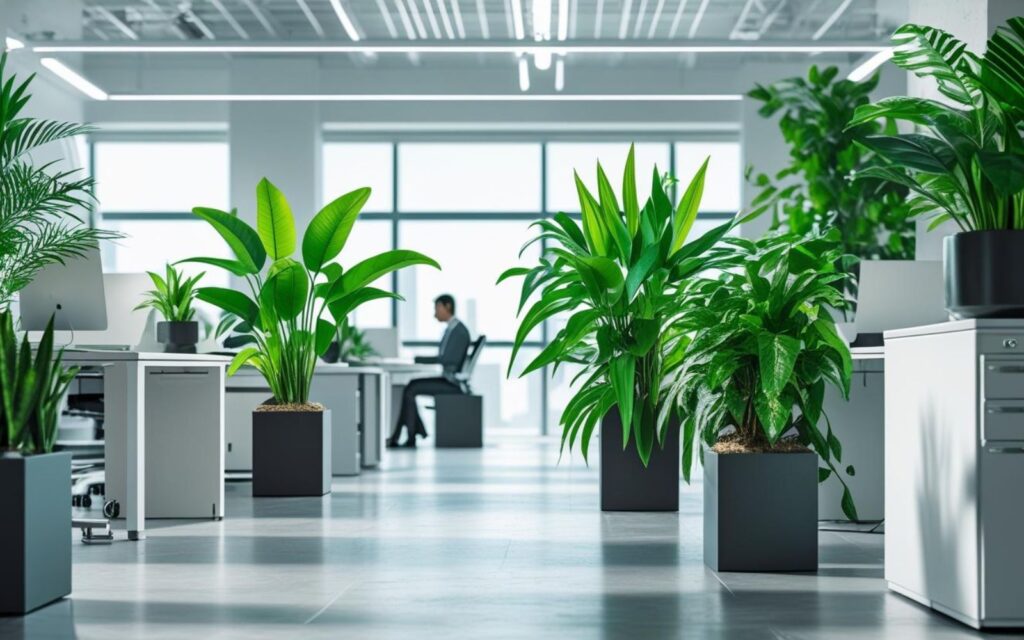
Plants are natural air filters, removing harmful toxins and refreshing indoor air.
They absorb pollutants like formaldehyde, benzene, and carbon dioxide, increasing relative humidity and releasing oxygen.
Key Benefits of Air Purifying Plants:
- Improved Air Quality: Snake plants, rubber trees, and spider plants remove harmful chemicals from the air.
- Humidity Regulation: Plants like peace lilies help regulate humidity, preventing dry skin and irritation.
- Natural Air Purifiers: Indoor plants act as air filters, reducing airborne pollutants.
Best Air Purifying Plants for Offices:
- Snake Plant: Removes formaldehyde and thrives in low light.
- Peace Lily: Filters out harmful toxins and adds natural scents.
- Spider Plant: Excellent at removing carbon dioxide and other airborne particles.
Health Benefits of Incorporating Plants in Indoor Spaces
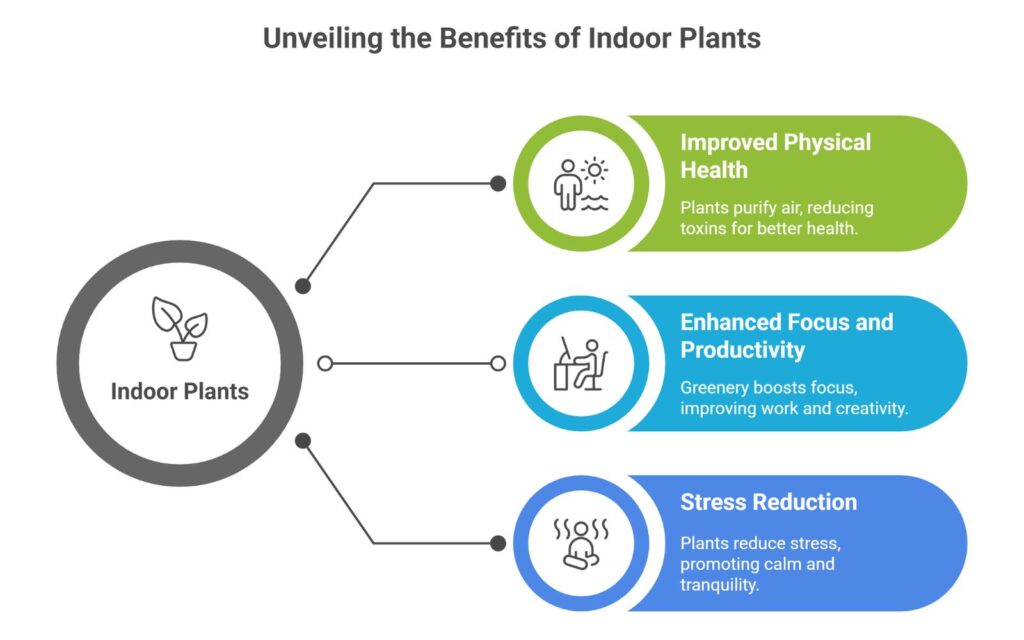
Adding plants to your office environment doesn’t just improve air quality-it enhances your mental and physical well-being.
a) Stress Reduction and Mental Well-Being
Being surrounded by natural elements, such as plants, has been shown to reduce stress and promote mental well-being.
Green spaces provide a calming effect, helping employees feel more relaxed and focused.
Example: Placing a peace lily on your desk can reduce mental fatigue and promote a sense of calm.
b) Improved Focus and Productivity
Cleaner air leads to better brain function, reducing fatigue and increasing productivity.
Natural air purifiers, such as the snake plant, release oxygen, creating a fresher office environment that supports a more productive workspace.
Best Options for Focus:
- Areca Palm: Boosts oxygen levels in office spaces.
- Rubber Plant: Combines air purification with a decorative element.
c) Physical Health Benefits
Air-purifying plants reduce exposure to harmful toxins, improving respiratory health and minimizing symptoms of sick building syndrome.
They also help combat dry skin and irritation by balancing humidity levels in indoor environments.
Choosing the Best Air Purifying Plants for Office Spaces
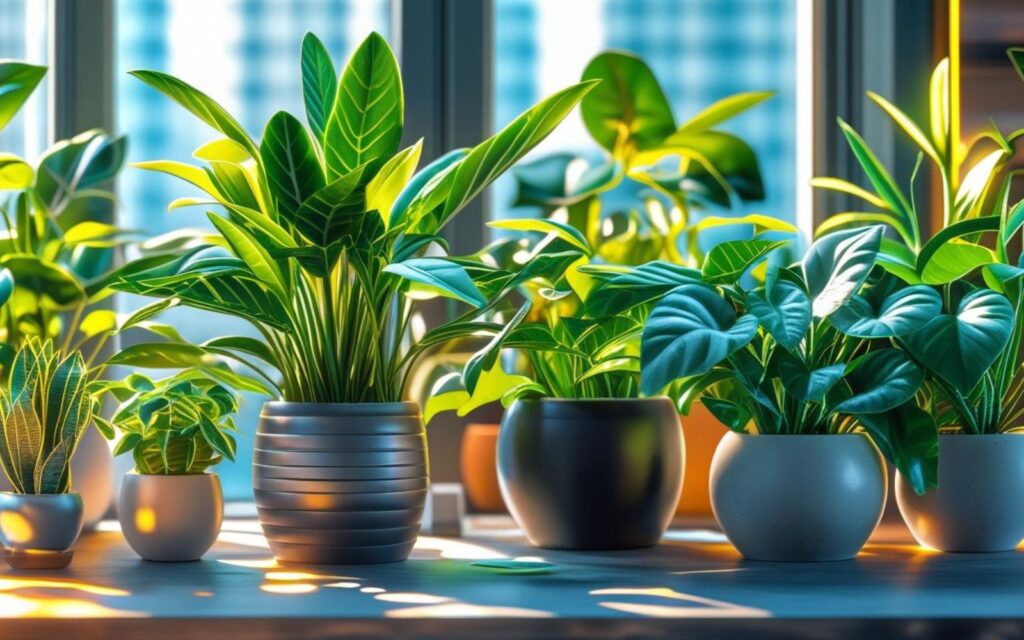
The right plant species can thrive in various light conditions and require minimal watering, making them perfect for busy office environments.
Low-Maintenance Plants for Offices:
- Snake Plant: Thrives in low light and requires minimal watering.
- Spider Plant: Hardy and effective at removing harmful toxins.
- Rubber Tree: A stylish addition that purifies air and adds natural beauty.
Plants for Indirect Sunlight:
- Peace Lily: Ideal for medium light and humid conditions.
- Dracaena: Adds greenery and removes volatile organic compounds.
Easy Indoor Plants for Desk Spaces:
- Pothos: Grows well in indirect light and improves indoor air.
- Succulents: Decorative and easy to care for.
How to Incorporate Plants Into Your Office Environment

Incorporating plants into your office doesn’t require a complete redesign. Start small and expand as you see the benefits.
Placement Tips:
- Use medium-sized plants, such as rubber plants, in common areas.
- Place low-maintenance plants, such as snake plants, on desks.
- Add decorative elements with succulents in meeting rooms.
Maintenance Tips:
- Proper Ventilation: Ensure plants get enough natural air to thrive.
- Minimal Watering: Avoid overwatering, especially for low-light species.
- Light Conditions: Choose plants that match the office’s natural light availability.
Pro Tip: Rotate plants occasionally for even growth and better light exposure.
Transforming Office Air Quality and Culture
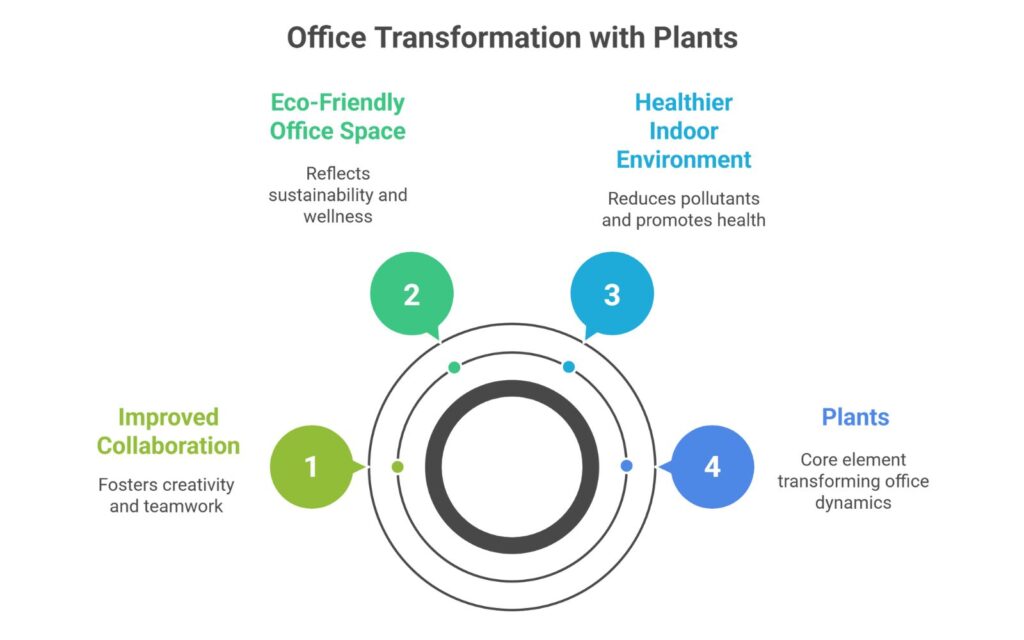
Plants do more than purify air-they transform your office culture and environment.
- Healthier Indoor Environment: Fresh air and reduced pollutants promote employee health.
- Eco-Friendly Office Space: Plants reflect a commitment to sustainability and wellness.
- Improved Collaboration: A natural office space fosters creativity and teamwork.
Summary
Air-purifying plants in offices are more than decorative elements -they’re essential for a healthier, more productive environment.
These natural air purifiers filter out harmful chemicals, regulate humidity, and bring fresh air to indoor spaces. From reducing stress to boosting focus, the benefits of air-purifying plants are undeniable.
Key Points:
- Enhance air quality with low-maintenance plant species, such as the snake plant, spider plant, and rubber plant.
- Promote mental well-being by incorporating natural elements and green spaces.
- Create a more productive and healthier indoor environment with strategic plant placement.
Start small by choosing easy-to-care-for indoor plants, and watch as your office space becomes a hub of well-being and productivity.
Frequently Asked Questions
What Are the Best Air Purifying Plants for Offices?
The best air-purifying plants include the snake plant, spider plant, peace lily, rubber plant, and pothos. They’re low-maintenance and improve indoor air quality.
How Do Air-Purifying Plants Help with Indoor Air Quality?
Plants remove harmful toxins, regulate humidity, and release oxygen, creating a fresher and healthier indoor environment.
Can Air-Purifying Plants Survive in Low Light?
Yes, many air-purifying plants like the snake plant and peace lily thrive in low-light conditions, making them ideal for offices.
How Do Plants Reduce Stress in the Office?
Plants create a calming atmosphere and improve air quality, which helps reduce mental fatigue and stress through natural stress reduction methods.
How Do I Maintain Office Plants?
Select low-maintenance plants, water them sparingly, and provide adequate lighting conditions. Dust their leaves occasionally for optimal air purification.

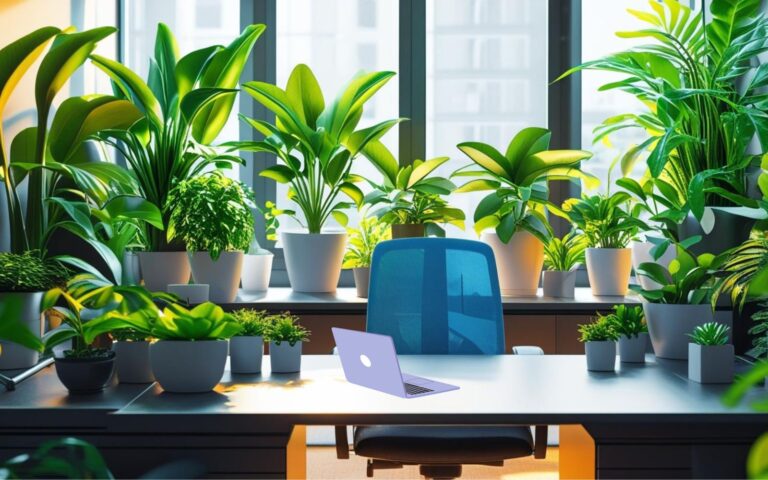
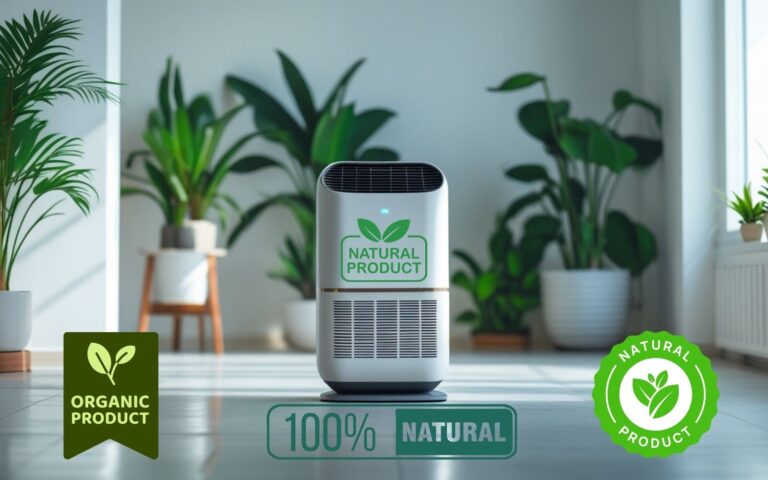


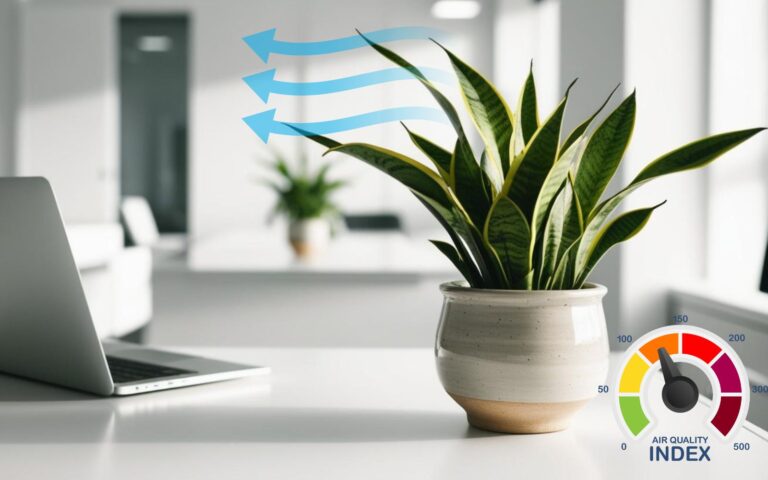
One Comment